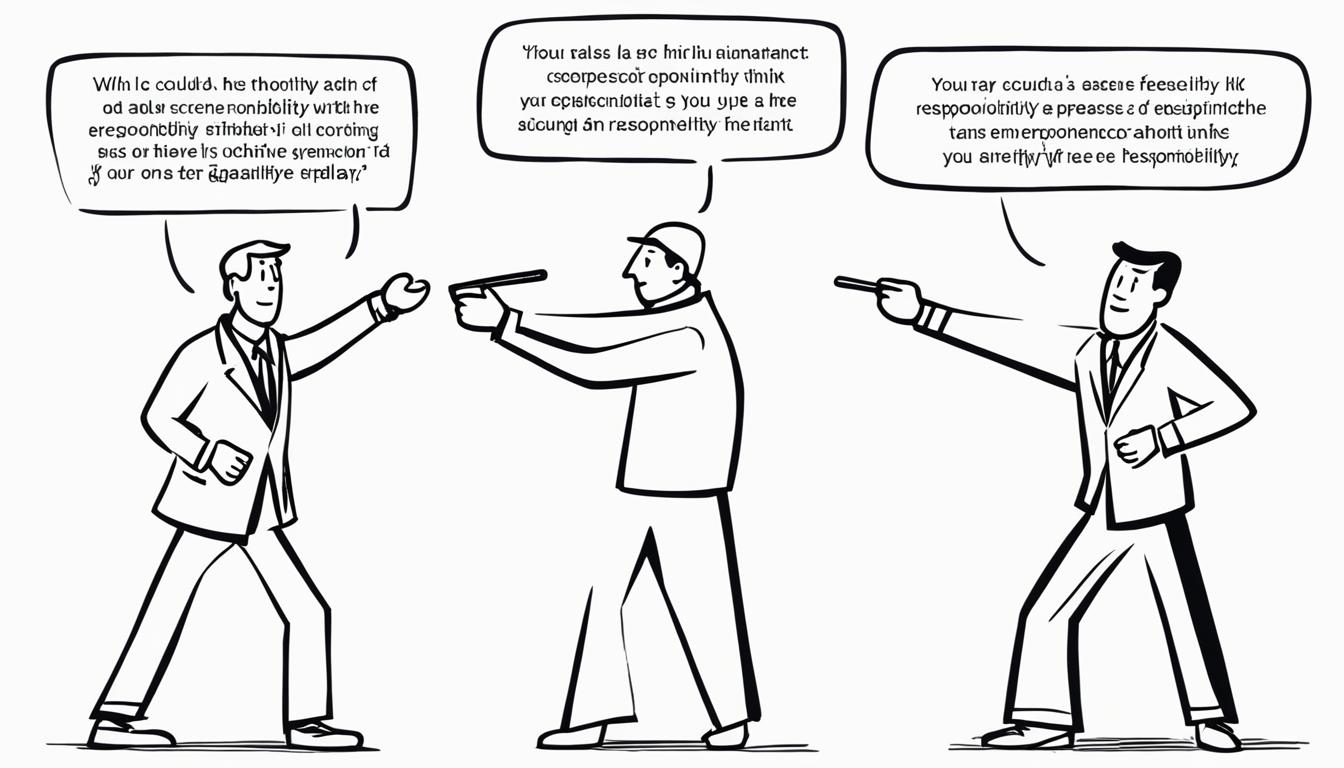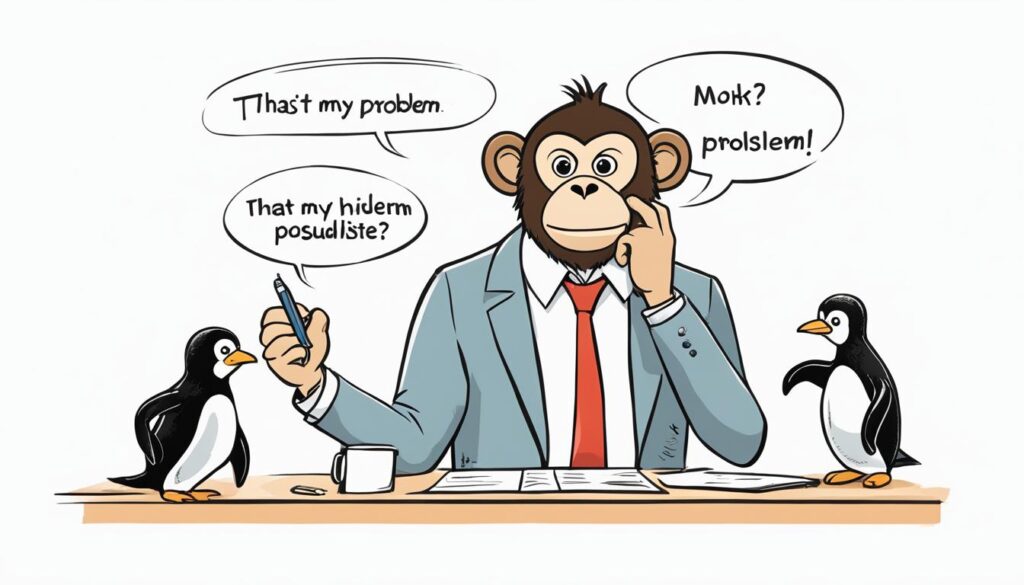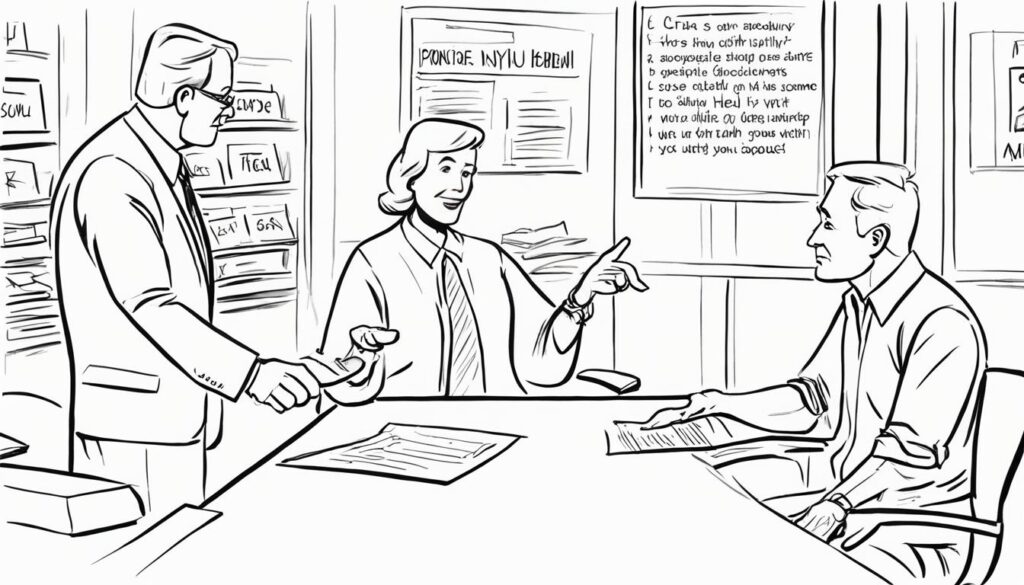Do you ever find yourself searching for different ways to express the idea of “that’s not my problem”? Are you tired of using the same old phrase in conversations? If so, you’ve come to the right place! In this article, I will provide you with a collection of alternative phrases and expressions that can be used to politely decline taking ownership or responsibility for a specific issue or task.
When faced with a situation where you want to convey that something is not your responsibility, it’s essential to choose the right words. By using alternative expressions, you can maintain professionalism and avoid sounding dismissive. Let’s dive into the world of responsibility expression and explore various ways to say “that’s not my problem” without dampening the conversation.
Professional Ways to Say “That’s Not My Problem”
In the professional realm, it is important to respond to inquiries and concerns in a courteous and respectful manner. When faced with a situation where you need to decline taking ownership or responsibility for a problem, there are professional alternatives to saying “that’s not my problem.” By using these expressions, you can maintain a professional tone while clearly indicating that the issue falls outside your area of responsibility.
“I’m afraid I can’t assist with that matter.”
This phrase demonstrates your willingness to contribute, while politely acknowledging that you are not the right person to resolve the issue. It conveys professionalism and a respect for boundaries, making it a suitable response in formal settings.
“It’s beyond the scope of my responsibility.”
This statement emphasizes that the matter is not within your jurisdiction or expertise. By using this phrase, you are highlighting your understanding of your role and responsibilities, while still maintaining a professional and respectful tone.
It is essential to choose your words carefully, as they can greatly impact the perception others have of you in the professional world. By utilizing these professional alternatives, you can gracefully decline taking ownership of problems without jeopardizing your professional reputation or relationships.
Professional Alternatives to “That’s Not My Problem”
| Professional Expression | Meaning |
|---|---|
| “I’m afraid I can’t assist with that matter.” | Indicates inability to provide assistance due to lack of expertise or responsibility. |
| “It’s beyond the scope of my responsibility.” | Conveys that the issue falls outside of your designated area of work. |
Using these professional phrases demonstrates your commitment to professionalism and respect while declining responsibility for an issue. They ensure effective communication, allowing a clear understanding of your role and boundaries in the workplace.
Funny Ways to Say “That’s Not My Problem”
In life, it’s often necessary to handle tricky situations with a hint of humor. When it comes to declining responsibility, why not lighten the mood with some funny alternatives to saying “that’s not my problem”? Here are a few humorous responses that will bring a smile to your face:
- “It’s got nothing to do with me!”
- “That falls outside of my jurisdiction.”
These witty phrases add a touch of playfulness while effectively conveying the message that the problem at hand is not your responsibility. So the next time you find yourself faced with a task that’s not your cup of tea, feel free to sprinkle some humor into your response.
“In the realm of humor lies the perfect refuge to gracefully decline the burdens that do not belong to us.”
Using Humor to Navigate Responsibility
Employing humor can be a valuable tool when dealing with challenging situations or declining responsibility. It allows you to diffuse tension, create a positive atmosphere, and maintain healthy relationships with those around you.
| Benefits of Using Humor | Examples |
|---|---|
| Lightens the mood | “It seems this job requires a master magician, and I’m more of a apprentice wizard.” |
| Builds rapport | “I’m sorry, but my expertise stops precisely at the intersection of hilarity and snacks.” |
| Creates a memorable response | “As much as I’d love to help, my talents are better suited for world-saving endeavors.” |
Using humor to navigate responsibility allows you to decline tasks or problems assertively while maintaining a positive and lighthearted approach. Just remember to gauge the situation and ensure that your humor is well-received by all parties involved.
When Is It Okay to Say “That’s Not My Problem”?
While there are appropriate situations for declining responsibility and using the phrase “that’s not my problem,” it is important to use it in the right context. It is best suited for informal conversations rather than professional emails or formal settings. This phrase can be used to remind someone that their problem is not your responsibility or that you are not the appropriate person to address it.
Declining responsibility is appropriate when:
- The issue falls outside of your area of expertise or job description.
- You have already delegated the responsibility to someone else who is in a better position to handle it.
- The problem is not directly related to your role or responsibilities within the organization.
- You have already taken steps to address the issue but have reached a dead-end.
Saying “that’s not my problem” is a way to set boundaries and clarify your scope of responsibility. It allows you to focus on tasks that align with your expertise and can contribute effectively to the overall objectives of your role.
Example Situation:
Colleague: “Can you help me with this customer complaint? It’s not going well.”
You: “I understand your frustration, but handling customer complaints is not within my role. You should contact our customer support team to resolve the issue.”
By politely declining responsibilities that are not yours, you can ensure that tasks are appropriately assigned and prevent unnecessary stress and confusion. It is essential to communicate your boundaries and focus on your core responsibilities to maintain a healthy work environment.
Handling Requests Outside of Your Job Description
Sometimes, I find myself in situations where I am asked to do something that is not part of my job description. It can be tempting to take on additional tasks or responsibilities, but I have learned the importance of setting boundaries at work and declining tasks that are outside of my responsibilities. By doing so, I am able to maintain a healthy work-life balance and prevent burnout.
When faced with a request that falls outside of my job description, I handle it professionally by saying “this is not my job.” It is crucial to communicate this in a polite and respectful manner, acknowledging that I have limitations and responsibilities that should not be exceeded. By setting these boundaries, I am able to protect my mental health and focus on what I was hired to do.
“Setting boundaries is not only about saying ‘No,’ but also about saying ‘Yes’ to what truly matters.”
I have found that there are several strategies that can help me decline tasks outside of my responsibilities effectively:
- Redirecting the request: I may politely redirect the person making the request to the appropriate department or individual who is better equipped to handle it.
- Explaining my current workload: I can emphasize my current workload and existing priorities to convey that taking on additional tasks would hinder my ability to fulfill my core responsibilities effectively.
- Suggesting an alternative solution: In some cases, I may propose an alternative solution or offer guidance on how the task can be accomplished without my direct involvement.
By utilizing these strategies, I ensure that I am maintaining a healthy workload and not taking on tasks that are outside of my expertise or job description. This not only benefits me but also allows others to recognize and respect my professional boundaries. Each time I decline a task that is not my responsibility, I am reinforcing the understanding that my role is defined by my job description.
Setting Boundaries as a Form of Self-Care
Setting boundaries at work is not only about protecting my time and energy but also about prioritizing my mental health. By saying “no” to tasks that are not my responsibility, I am safeguarding myself from burnout and maintaining a sustainable work-life balance.
It is crucial to remember that declining tasks outside of my job description does not make me less capable or dedicated. It simply means that I am aware of my limitations and committed to performing my primary duties to the best of my abilities.
| Benefits of Setting Boundaries | Effects of Declining Tasks Outside of My Responsibilities |
|---|---|
| I can focus on my core responsibilities. | I avoid spreading myself too thin and becoming overwhelmed. |
| I have more time and energy for tasks that align with my expertise. | I can deliver higher quality work by focusing on what I do best. |
| I am able to maintain a healthy work-life balance. | I prevent work from encroaching on my personal life and well-being. |
| I protect my mental health and avoid burnout. | I prioritize self-care and prevent excessive stress. |
Remember, it is okay to say “not my job” when faced with tasks outside of your responsibilities. Setting boundaries is a form of self-care and essential for maintaining a healthy and fulfilling work environment.
Saying “I Wasn’t Aware of That” as a Response to Blame
When confronted with blame or criticism, I find it beneficial to respond with phrases like “I wasn’t aware of that.” This allows me to explain that any mistakes I made were due to a lack of information or instruction. By using this response, I am acknowledging my accountability while highlighting the fact that I was not provided with all the necessary details to prevent the error.
Blame is often a knee-jerk reaction, and it’s important not to let it consume us. Instead of becoming defensive or attempting to shift blame onto others, which can create a hostile atmosphere, it’s more productive to focus on finding a solution. Responding with “I wasn’t aware of that” opens the door for further discussion and clarification, promoting a positive and constructive dialogue.
“I wasn’t aware of that” allows me to take responsibility for my actions while also emphasizing the need for clear communication and proper information sharing. It opens the door for productive conversations and paves the way for finding solutions.”
It’s crucial to remember that mistakes can happen when there is a lack of information or instruction. We are not omniscient beings, and it is unreasonable to expect us to know everything at all times. By responding with “I wasn’t aware of that,” we communicate that we are accountable for our actions while also highlighting the importance of transparent communication and clear expectations within a team or organization.
In situations where blame is placed upon us, it’s easy to become defensive or overwhelmed. However, embracing a calm and open-minded approach can lead to a more productive resolution. By using the phrase “I wasn’t aware of that,” we are able to navigate through blame and criticism while promoting understanding, collaboration, and growth.
| Benefits of Responding with “I Wasn’t Aware of That” | How It Helps |
|---|---|
| 1. Promotes accountability | By acknowledging our responsibility in the situation |
| 2. Fosters open communication | By encouraging further discussion and clarification |
| 3. Facilitates finding a solution | By shifting the focus from blame to problem-solving |
Explaining Your Thought Process to Deflect Blame
In difficult situations where blame is being unfairly directed towards me, I have found that explaining my thought process can be a powerful way to deflect unfounded accusations. By justifying my decisions and providing context for my actions, I can effectively communicate the reasons behind my choices, helping others understand that it was not a mistake but a deliberate decision made in the best interest of the situation.
When faced with blame, it is crucial to remain calm and composed. By approaching the situation with a clear mind, I can effectively articulate the rationale behind my actions. I emphasize the importance of taking a step back and examining the circumstances that led to my decision, enabling me to present a well-rounded explanation.
One effective way to explain my thought process is through using real-life examples or relatable scenarios. By sharing relatable experiences, I can help others empathize and grasp the complexities of the situation. This approach allows for a deeper understanding and promotes a more constructive and collaborative discussion.
For instance, imagine the responsibility of choosing a marketing strategy for a new product launch. If I made a decision that may seem questionable at first, I can outline the factors I considered, such as market research, customer demographics, and competitor analysis. By offering this perspective, my colleagues or superiors can comprehend the reasoning behind my choice, recognizing that it was a well-thought-out decision based on available information. This shifts the focus from blame to understanding, fostering a more productive and open-minded environment.
Furthermore, providing concrete evidence to support my decisions strengthens my case and reinforces the validity of my choices. Statistics, data analysis, or expert opinions can add credibility to my explanations, demonstrating that I relied on substantial information rather than making uninformed or hasty decisions.
Applying Logic and Reasoning
The power of logical reasoning cannot be underestimated when explaining my thought process. By breaking down my decision-making process into clear steps, I can help others see the progression of thought and the considerations made along the way.
I find it helpful to address any possible alternative solutions or approaches that were considered and explain why they were not pursued. This demonstrates that I carefully assessed multiple options and concluded that my chosen course of action was the most appropriate based on the circumstances.
Ultimately, by explaining my thought process during times of blame, I aim to shift the narrative from finger-pointing to collaboration. When others understand the reasoning behind my decisions and the careful thought I put into them, it helps foster a supportive environment where mistakes are seen as learning opportunities rather than reasons for rebuke.
Comparing Strategies for Explaining Thought Process
| Approach | Benefits | Considerations |
|---|---|---|
| Using relatable examples | Enhances understanding and empathy | Requires careful selection of scenarios based on the audience |
| Presenting concrete evidence | Increases credibility and validity | Requires reliable data or expert opinions |
| Applying logic and reasoning | Provides a structured and clear explanation | Requires thorough analysis and consideration of alternative solutions |
Remember, when faced with blame, it is important to remain calm and composed. Explaining our thought process can help others understand the rationale behind our decisions, fostering a collaborative work environment where blame is less prevalent and learning is prioritized.
Transitioning Blame to a Team Discussion
When I find myself being blamed for something that was actually the fault of a colleague, addressing the situation without throwing my coworker under the bus can be quite challenging. In such delicate instances, I discovered a strategic approach that not only deflects blame but also turns individual mistakes into a valuable team discussion, ultimately involving others in accountability.
One method that I have found effective is suggesting a team meeting to discuss the issue at hand. By proposing this approach, responsibility can be shared among the entire department, encouraging collective problem-solving and fostering a culture of mutual support and growth. This allows my teammate an opportunity to take accountability for their actions while providing a safe space for open discussion.
“Great things are rarely accomplished by individuals alone, but rather through collaborative efforts.”
By engaging in a team discussion, we can delve into the root causes of the mistake, identify areas for improvement, and collectively develop strategies to prevent similar errors in the future. This not only strengthens the bond within the team but also shows a commitment to continuous learning and growth.
Benefits of Transitioning Blame to a Team Discussion
Transitioning blame to a team discussion offers several advantages:
- Promotes a supportive and collaborative work environment
- Encourages transparency and open communication
- Shares accountability among team members
- Fosters a culture of learning and improvement
- Reduces the likelihood of repeated mistakes
Working as a team not only keeps relationships intact but also ensures a more productive and harmonious work environment. By involving others in the accountability process, we can collectively learn from our mistakes and grow together as a cohesive unit.
| Individual Mistakes | Turning Into a Team Discussion |
|---|---|
| Focuses on attributing blame and pointing fingers | Encourages accountability and growth |
| Creates a hostile work environment | Promotes trust and collaboration |
| Leads to a culture of fear and avoidance | Fosters a culture of learning and improvement |
| Repeats mistakes due to lack of discussion | Prevents repeated errors through shared strategies |
Dealing with Unfair Blame and Maintaining Your Reputation
In the course of our professional lives, we may find ourselves facing undeserved blame for something we did not do. This unjust assignment of fault can pose a threat to our reputation and have a negative impact on our career. However, it is essential to respond in a way that preserves our professional standing while avoiding the trap of sounding whiny or defensive.
One method to address undeserved blame is by calmly explaining the facts surrounding the situation. By providing clear and concise information, I can bring attention to the inaccuracies and inaccurately placed responsibility. During this explanation, it is important to maintain a composed demeanor, focusing on the facts, and avoiding emotional outbursts. By doing so, I demonstrate my dedication to accuracy and truth.
Another effective strategy is to seek support from colleagues or superiors who are familiar with my work and can vouch for my integrity. This can be accomplished by discussing the situation privately and respectfully with individuals who have witnessed my dedication and expertise. Their professional testimonial can help counteract the unfair blame and provide a much-needed perspective to those involved.
Remembering the Power of Documentation
Documentation plays a crucial role when dealing with undeserved blame. By keeping detailed records of my work, communications, and any relevant evidence, I can strengthen my defense when faced with false accusations. These records can serve as irrefutable proof of my actions, ensuring that the truth prevails.
“In situations where I am confronted with unwarranted blame, I rise above the noise, armed with facts and the support of those who know my worth.”
Moreover, it is important to avoid sounding whiny or defensive when responding to unfair blame. Instead of focusing on the injustice itself, I redirect the attention to the larger picture, highlighting the importance of cooperation and collaboration in any professional setting. By emphasizing the need for mutual understanding, I can contribute positively to the resolution of the issue at hand.
In conclusion, when faced with undeserved blame, it is crucial to respond in a manner that preserves our professional reputation. By calmly presenting the facts, seeking support from colleagues, documenting our work, and avoiding a defensive tone, we can navigate through these challenging situations with poise and integrity. Remember, our reputation is a valuable asset that should always be protected.
Setting Boundaries and Declining Requests Outside of Your Role
As I navigate the demands of the modern workplace, I have come to realize the importance of setting boundaries. It is essential for my well-being and mental health that I decline requests or tasks that fall outside of my role or capacity. By doing so, I not only protect my own sanity but also ensure that I can devote my energy and expertise to the areas where I can make the greatest impact.
When faced with additional responsibilities that are beyond my scope, I approach the situation with grace and clarity. Instead of simply saying “no,” I take the time to explain why I am unable to take on the task. By providing a rational and honest response, I can foster understanding and maintain a positive working relationship with my colleagues.
“I appreciate your confidence in my abilities, but this task falls outside of my expertise. I believe it would be more efficient and effective if it were assigned to someone with the appropriate skills.”
It is crucial to remember that declining additional responsibilities does not equate to incompetence or an unwillingness to contribute. By setting boundaries, I am prioritizing my well-being and ensuring that I can fulfill my existing responsibilities to the best of my abilities.
Protecting my mental health is paramount, and saying “no” to tasks that do not align with my role is a necessary step in maintaining a healthy work-life balance.
Strategies for Politely Declining Additional Responsibilities:
- Clearly communicate your current workload and the priorities you have.
- Suggest an alternative solution or recommend a colleague who may be better suited for the task.
- Offer to provide guidance and support to the person taking on the responsibility.
- Reiterate your commitment to your existing responsibilities and express gratitude for the opportunity.
By employing these strategies, I can decline additional responsibilities while maintaining professionalism and respect. It is important to remember that saying “no” does not make me any less valuable or dedicated to my work. It demonstrates my ability to prioritize and protect my mental well-being.
Setting boundaries and declining requests outside of my role has been instrumental in safeguarding my mental health and maintaining a fulfilling work-life balance. It allows me to focus on the tasks that reflect my expertise and contribute to the overall success of the team.
| Benefits of Setting Boundaries and Declining Additional Responsibilities | How it Supports Your Mental Health |
|---|---|
| Reduces stress and overwhelm | By not overloading yourself with tasks that are beyond your capacity, you can reduce stress and prevent burnout. |
| Increases productivity | By focusing on your core responsibilities, you can dedicate your time and energy to tasks where you can make the greatest impact. |
| Promotes work-life balance | By setting boundaries and saying “no” to tasks outside of your role, you create space for personal time and activities that bring you joy. |
| Enhances professional growth | By declining tasks that are not aligned with your expertise, you create opportunities for others to shine and open doors for their growth, while also advancing your own development in your core area. |
Remember, you have the right to protect your mental health and well-being. Setting boundaries and declining additional responsibilities is not a sign of weakness, but rather a reflection of your self-awareness and commitment to maintaining a healthy and fulfilling work environment.
Seeking Clarification and Requesting Assistance
When faced with a task or responsibility that I am unsure about, I understand the importance of seeking clarification and asking for assistance. By doing so, I can avoid making mistakes due to a lack of information and ensure that I am able to successfully fulfill my responsibilities.
Asking for clarification allows me to gain a better understanding of what is expected of me. Whether it’s through email, a phone conversation, or a face-to-face meeting, I make an effort to reach out to the appropriate person and ask for further explanation. By doing this, not only am I showing my commitment to getting the job done right, but I am also demonstrating my willingness to learn and grow in my role.
Additionally, I recognize that I don’t have to face challenges alone. When uncertain or overwhelmed, I am not afraid to seek help from my colleagues, supervisors, or mentors. Their guidance and expertise can provide me with the knowledge and support I need to navigate unfamiliar territory and overcome obstacles. By reaching out to others, I am strengthening relationships, fostering a collaborative work environment, and ensuring that the task at hand is executed effectively.
“Asking for help is not a sign of weakness; it is a sign of strength and a desire for improvement.”
Seeking clarification and requesting assistance are essential habits to cultivate in any professional setting. By actively seeking the information and support I need, I am setting myself up for success and demonstrating my commitment to producing high-quality work. Remember, we are not expected to know everything, but we are expected to take the initiative to ask the right questions and seek guidance when necessary.
By embracing a mindset of curiosity and a willingness to learn, I am able to avoid mistakes that may arise from a lack of information or understanding. Through open communication and a collaborative spirit, I am able to seek the clarification and assistance needed to excel in my responsibilities and contribute to the overall success of the team.
| Benefits of Seeking Clarification and Requesting Assistance | Actions to Take |
|---|---|
| 1. Avoiding costly mistakes | 1. Reach out to the appropriate person for further explanation |
| 2. Demonstrating willingness to learn and grow | 2. Seek help from colleagues, supervisors, or mentors |
| 3. Building strong relationships | 3. Embrace a mindset of curiosity and a willingness to learn |
| 4. Fostering a collaborative work environment | 4. Engage in open communication |
| 5. Ensuring task execution effectiveness | 5. Take the initiative to ask the right questions |
Conclusion
In the realm of professional communication, there exists a plethora of ways to gracefully decline ownership or responsibility for matters that do not fall within our realm. By embracing alternative phrases and explanations, we can tactfully navigate the delicate art of saying “that’s not my problem.” These strategies enable us to maintain professional decorum while setting boundaries and prioritizing our well-being.
It is crucial to safeguard our mental health and preserve work-life balance by clearly defining our roles and declining tasks that exceed our responsibilities. This practice ensures that we can excel in our designated areas and avoid burnout. Remember, seeking clarification and assistance when faced with uncertainty is a sign of strength, enabling us to avoid errors and misunderstandings that could impact our professional reputation.
In conclusion, adopting an empathetic approach to communication empowers us to express our limitations with grace and respect. By embodying these principles, we can foster a work environment that supports mutual understanding and collaboration. Let us remember to strike a balance between accountability and self-preservation, as we navigate the intricate dance of professional interactions.
Source Links
- https://wordselector.com/other-ways-to-say-thats-not-my-problem/
- https://pumble.com/blog/say-this-is-not-my-job-professionally/
- https://www.themuse.com/advice/better-ways-to-say-its-not-my-fault-at-work














